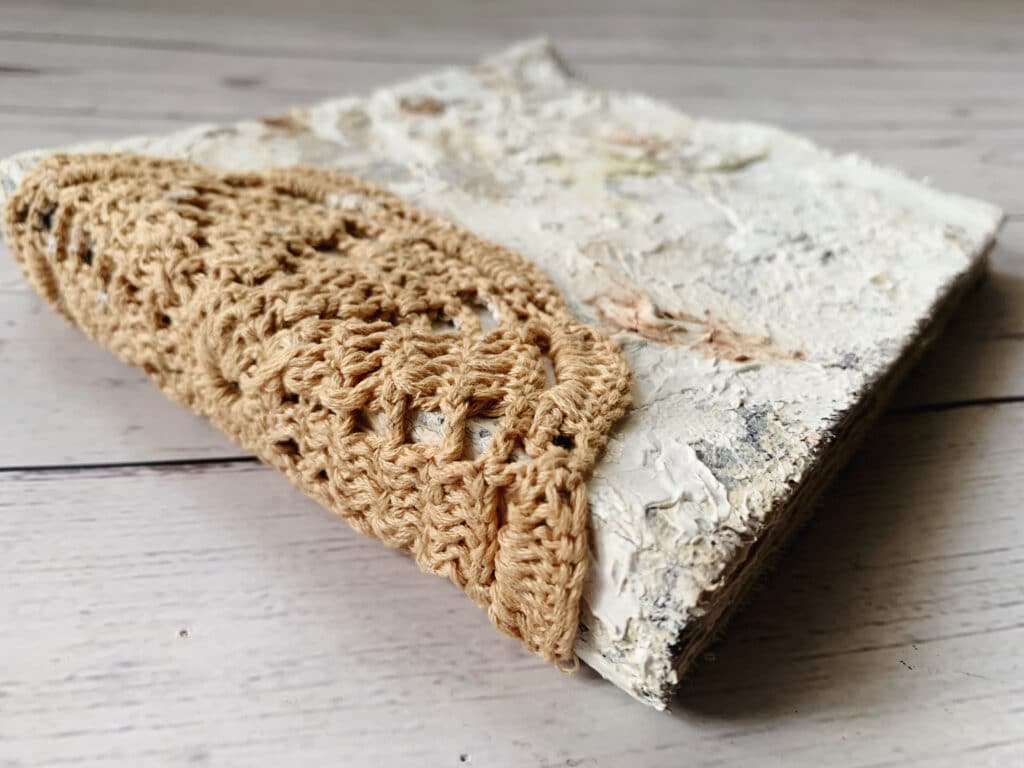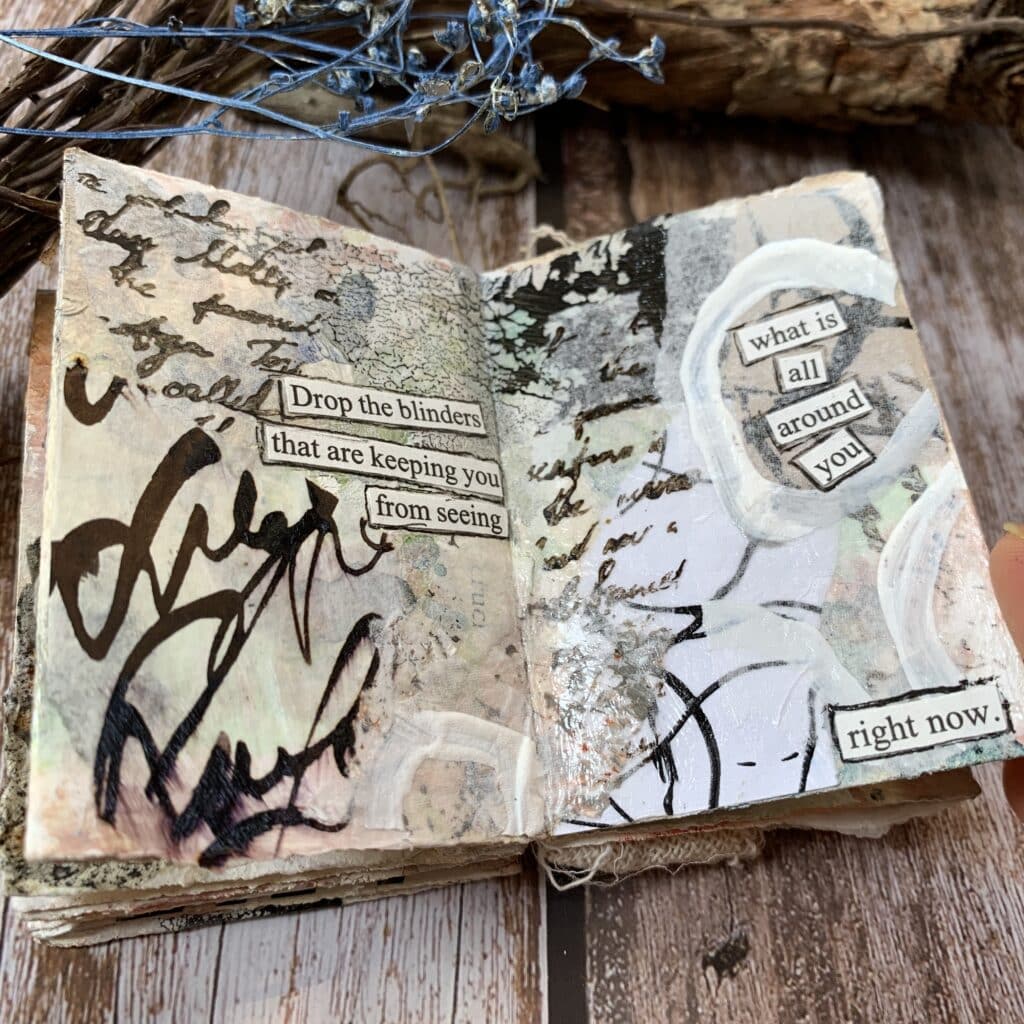Art journaling is a versatile and deeply personal practice that enables artists to explore their creativity, express emotions, and engage in experimentation. It’s a space where the process of creation often takes precedence over the final outcome. While there are numerous approaches to art journaling, it can broadly be categorized into five main types:
1. Creating Beautiful Art in a Sketchbook
- Purpose: This type of art journaling focuses on creating visually appealing pieces with a clear outcome in mind. The goal is to produce art that stands on its own, often reflecting themes like abstract botanicals or intricate patterns.
- Artists:
- Alisa Burke: Alisa’s work is characterized by vibrant colors and bold patterns. Her sketchbooks often feature abstract designs inspired by nature, with a playful mix of textures and techniques that highlight her love for experimentation.
- Carol Nelson: Carol’s abstract mixed media art emphasizes texture and color. Her sketchbooks are filled with dynamic compositions that explore various materials and layering techniques to create striking visual effects.
- Laura Horn: Laura combines abstract patterns with botanical themes in her sketchbooks. Her work often features soft, layered compositions with subtle, nature-inspired motifs that create a harmonious and tranquil visual experience.
- Wendy Brightbill: Wendy’s art is known for its bright, energetic colors and mixed media techniques. Her sketchbooks are filled with lively, expressive pieces that celebrate the beauty of creativity and spontaneous mark-making.
- Louise Fletcher: Louise creates engaging art pieces using bold colors and dynamic compositions. Her sketchbooks reflect her interest in abstract forms and expressive techniques, resulting in visually captivating works.
- Marabeth Quin: Marabeth’s sketchbooks feature vibrant abstract art with a focus on color and texture. Her work often includes mixed media elements and layering techniques, creating visually rich and engaging compositions.
2. Junk Journaling
- Purpose: Junk journaling involves using found materials, vintage ephemera, and layering to create textured, meaningful pages. This approach often emphasizes the joy of collecting and assembling rather than producing a polished final product.
- Artists:
- BB Henry Art: BB Henry Art specializes in using vintage and found materials to create layered, textured art. Her junk journals are characterized by a rich combination of papers, fabrics, and ephemera, resulting in visually complex and tactile pages.
- Get Messy Art: This community encourages the use of everyday materials and embraces imperfections. Get Messy Art’s junk journaling often features a mix of collected ephemera, collage, and layered textures that celebrate creative freedom and personal expression.
- Lisa Goddar: Lisa’s junk journaling involves the use of layered collages and found materials. Her work features intricate compositions where the joy of assembling various elements is central, creating deeply personal and textured pages.
- Megan Quinlan: Megan’s approach to junk journaling includes the use of rich textures and layers, combining various materials to create compelling visual effects. Her work emphasizes the beauty of collected objects and the creative possibilities they offer.
- Susan McCreevy: Susan’s art is focused on personal expression through layered collages and mixed media. Her junk journals often feature a combination of vintage ephemera and personal touches, resulting in visually engaging and meaningful pages.
- The Ugly Art Club: This community promotes the use of found materials and embraces imperfections. Their junk journaling often involves layering various ephemera and creating textured, expressive pages that highlight the beauty of the process.
- Rebecca Sower: Rebecca’s work blends vintage finds with collage and stitching. Her junk journals are filled with layered, textured pages that reflect a love for nostalgia and personal storytelling through art.
3. Collage-Based Journaling
- Purpose: Collage-based journaling focuses on using collage techniques with an emphasis on composition and design. It often involves layering different materials and adding minimal marks to enhance the visual impact of the page.
- Artists:
- Julie Hamilton: Julie is known for her intricate, layered collages and mixed media techniques. Her collage-based journaling involves carefully arranged elements and textures to create visually captivating and cohesive pages.
- Catherine Rains: Catherine’s collages blend vintage and modern elements, often exploring themes of identity and transformation. Her work in collage-based journaling features thoughtful compositions that incorporate a variety of materials.
- Eva Kalien: Eva’s collages are rich in texture and detail, using vintage papers and found objects to create layered, visually compelling pages. Her work often reflects a deep engagement with the materials and the process of layering.
- Orly Avineri: Orly’s approach to collage-based journaling involves layering and combining various materials to create expressive art. Her work often features a mix of textures and patterns, resulting in dynamic and visually interesting compositions.
- Fonda Clark Haight: Fonda uses mixed media and collage to explore personal themes and create visually engaging art. Her collage-based journaling often incorporates a variety of materials to create rich, textured pages.
- Jackie Bernardi: Jackie’s work combines collage with intuitive mark-making and layering. Her art journals often feature a blend of collaged elements and expressive marks, resulting in deeply personal and visually engaging pages.
4. Intuitive Art Journaling
- Purpose: Intuitive art journaling emphasizes spontaneity and emotional expression, allowing the artist’s inner thoughts and feelings to guide the creative process. This approach often results in deeply personal and reflective pieces, where the focus is on the journey rather than the destination.
- Artists:
- Galia Alena: Galia’s art explores themes of femininity and spirituality through abstract and expressive techniques. Her intuitive art journaling involves spontaneous mark-making and layered elements that reflect her inner thoughts and emotions.
- Jeanne Oliver: Jeanne uses mixed media to create art that tells a story and reflects personal exploration. Her intuitive art journals are filled with expressive, emotionally resonant pieces that capture her creative journey.
- Kasia Avery (Everything Art): Kasia’s raw and emotional art journaling involves spontaneous mark-making and a mix of materials. Her work reflects a deep connection to personal themes and the process of self-expression.
- Katrina Koltes: Katrina’s art is inspired by spirituality and nature, using watercolors, inks, and other materials to create ethereal, expressive pieces. Her intuitive art journaling captures the essence of her inner world and emotions.
- Laly Mille: Laly’s work blends delicate mark-making, collage, and washes of paint to create introspective pieces. Her intuitive art journaling reflects a deep emotional connection and a focus on the creative process.
- Louise Fletcher: Louise employs abstract, intuitive techniques to explore deep emotions and creativity. Her art journals feature bold colors and dynamic compositions that reflect her inner experiences.
- Tracy Verdugo: Tracy’s vibrant art journals use free-flowing patterns and bright colors to express joy and personal discovery. Her intuitive approach emphasizes the creative process and emotional expression.
5. Process Art Journaling
- Purpose: Process art journaling is centered on the creative journey, with an emphasis on experimentation, play, and exploring materials and techniques. The process itself is the main focus, with less concern for the final outcome, making it an ideal space for discovery and learning.
- Artists:
- Connie Solera: Connie’s art journaling focuses on creative experimentation and the joy of the artistic journey. Her work often involves trying out new techniques and materials, with an emphasis on the process rather than the final product.
- Effy Wild: Effy’s approach emphasizes self-exploration and personal growth through mixed media. Her process art journaling is filled with layers of paint, collage, and mark-making that reflect her creative journey and personal insights.
- Ivy Newport: Ivy is known for her focus on layering and experimenting with different media. Her process art journaling explores various techniques and materials, creating pages that document her artistic exploration and growth.
- Karen Elaine Creative: Karen’s work involves a wide range of materials and techniques, with a focus on the creative process. Her art journals feature experimental approaches and a playful engagement with different media.
- Marabeth Quin: Marabeth engages in the exploration of colors and textures, with a focus on the process of creation. Her art journals are filled with experimental techniques and layers that highlight her creative journey.
- Orly Avineri: Orly’s approach to process art journaling includes a variety of materials and methods, emphasizing the exploration of artistic techniques. Her work reflects a commitment to experimentation and discovery.
- Roxanne Coble (By Bun): Roxanne uses drawing, painting, and collage to create art through an experimental process. Her journals feature a mix of techniques and materials that capture her creative exploration.
- Tammy Garcia (Daisy Yellow): Tammy promotes daily creative practice and the exploration of different art techniques. Her process art journaling involves a playful and experimental approach, with an emphasis on the joy of creating.
Comparison Study:
| Category | Focus | Purpose | Techniques | Outcome | |
|---|---|---|---|---|---|
| Junk Journaling / Collage-Based Journaling | Collage, use of found materials, minimal mark-making | Capture memories, emotions, or stories through layering | Layered collages, use of ephemera, minimal painting | Less about a polished final product, more about assembling meaningful layers | |
| Intuitive Art Journaling | Spontaneity, emotional expression, connection with the subconscious | Express inner thoughts and feelings, reflect on personal themes | Free-flowing, abstract techniques, spontaneous marks | Deeply personal, emotionally resonant pieces that reflect the artist’s inner world | |
| Process Art Journaling | Experimentation, creative play, exploration of materials | Focus on the creative journey and discovery, less on outcome | Experimentation with different media, trial and error, layering | Unpredictable, emphasizes learning and discovery, records creative exploration |




